Koblenz is a charming city situated where the Moselle meets the Rhine river in western Germany. The town enjoys a mild climate and lovely natural scenery, surrounded as it is by vineyards, the rivers and the low hills of the Hunsrück, the Eifel, and the Westerwald ranges.
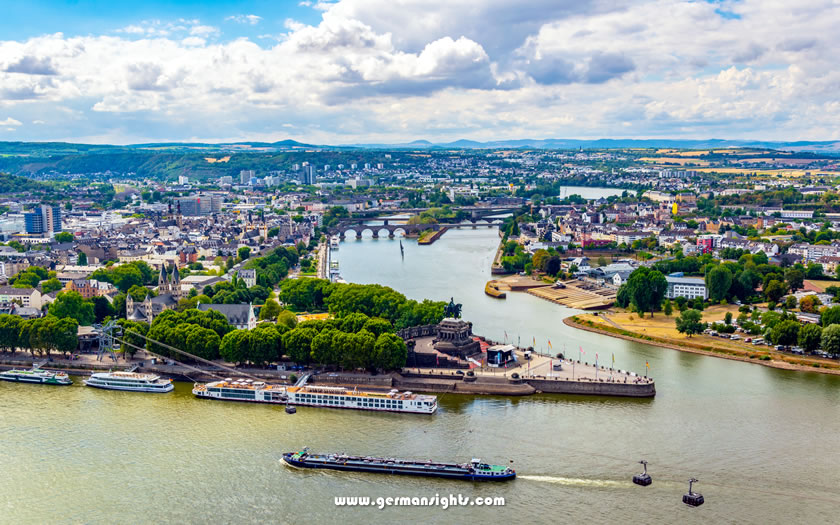
A view over the Mosel and Rhine at Koblenz
Must-see attractions include the iconic Deutsches Eck (the 'German Corner') where the two rivers meet and the Ehrenbreitstein Fortress ('Festung Ehrenbreitstein'), which also houses the Koblenz State Museum.
Koblenz's unique location on both banks of the Rhine and Mosel rivers makes it an excellent base for taking a romantic Rhine river cruise or exploring the Moselle valley.
Frankfurt Hahn airport to the south and Cologne-Bonn airport to the north are technically the closest to Koblenz.
Distance to Frankfurt Hahn Airport: 84km
Distance to Cologne-Bonn Airport: 91km
Distance to Frankfurt Airport: 112km
However all of the airports are around an hour's drive from Koblenz, with the larger Frankfurt airport making up for the slightly longer distance with convenient road and rail connections. The wider choice of airlines and destinations may also make it a more appealing option.
Koblenz has a multitude of rail lines and train stations within the city boundaries.
The main train station in Koblenz is Koblenz Hauptbahnhof. This is the stop for InterCity services across Germany as well as into Luxembourg and down to Austria.
Regional train services from the north and south, as well as from the Mosel valley and Frankfurt, all stop here as well.
Koblenz Hauptbahnhof is just over a kilometre south of the old town. An alternative is Koblenz Stadtmitte station ('Koblenz City Centre'). This is served by most of the regional trains on the lines heading north and is ten minutes' walk from the historic centre of the city.
There are also train stations with stops for regional services in various suburbs of the city. Koblenz Ehrenbreitstein is the only station on the right bank of the Rhine and is at the foot of the hill where the fortress is located.
The German rail service offers a ticket (Rheinland-Pfalz-Ticket + Lux) which includes unlimited travel on regional trains and bus services in the Rhineland-Palatinate, Saarland and Luxembourg for a day.
Koblenz has good connections into the German motorway system.
The A-61 motorway passes to the west of the city and links south to Mannheim and north to Bonn and Cologne.
The A-48 motorway passes to the north and west of the city and is the option for those heading east to Frankfurt or south-west to Trier.
There are accommodation options all over the city of Koblenz but most visitors will probably want to stay close to the water in the old town area or near to the main train station a little further south.
If you know when you are planning to go but haven't decided on accommodation, then use the map below to get an idea of which properties are available and to compare prices during the period you wish to travel.
Enter your proposed dates and use the '+' to zoom in on a location and reveal more properties. Click on the price above a property to see more information.
(Please note that this selection will also include some guesthouses, pensions and self-catering apartments for those who are interested in that form of accommodation!)
Alternatively, if you would like a list of properties available on your proposed dates of travel, use the search box below to find accommodation:
The Romans established a military camp at the confluence of the Moselle and Rhine rivers around the 1st century AD. They built a bridge over the Rhine and called the fortifications 'Castellum apud Confluentes'.
This is where the name Koblenz comes from. The Romans had recognised the strategic location and, over the following centuries, this helped it to become an important regional centre.
In the Middle Ages, Koblenz became part of the Holy Roman Empire. The original Ehrenbreitstein Fortress was built in the 12th century to control the two rivers and the city.
Over the following centuries, Koblenz was controlled by various powers, including the Electorate of Trier and the Archbishopric of Trier.
In the 18th and 19th centuries, Koblenz flourished as a centre of trade and industry. The city became part of the German Confederation in 1815 and of the Prussian Rhine Province in 1822. The French occupied the city for a short time after World War I.
Due to its strategic location and industry, Koblenz was heavily damaged by Allied bombing during World War II. The city was part of the French occupation zone in the post-war period.
It became part of the state of Rhineland-Palatinate in the new Federal Republic of Germany.
Koblenz was extensively rebuilt and redeveloped in the 1950s and 1960s. Many of its historic buildings and monuments have been restored.
Today, Koblenz is an economic centre within the region and a popular tourist destination thanks to its historic charm, scenic riverside location and cultural attractions.
It was an integral part of the listing of the 'Upper Middle Rhine Valley' as a UNESCO World Heritage Site in 2002. The 65-kilometre stretch of the river Rhine listed runs between Koblenz and Bingen.
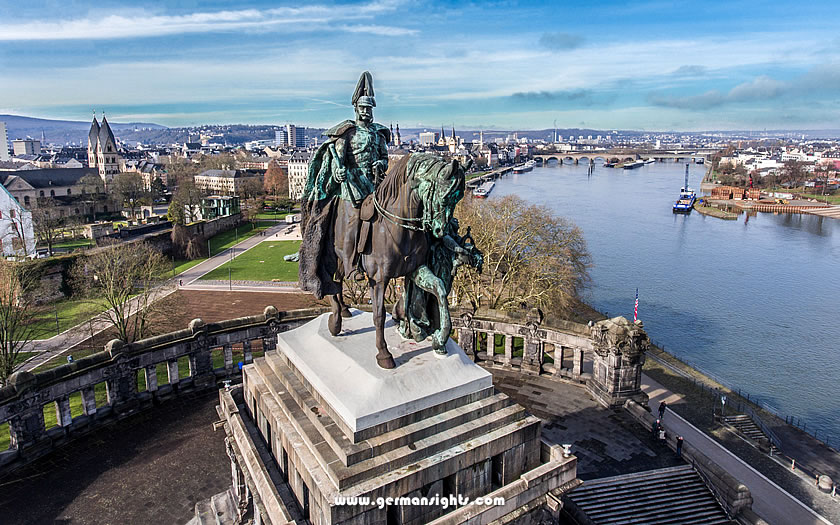
The statue of William II at the confluence of the river Mosel and river Rhine at Koblenz
The Deutsches Eck ('German Corner') in Koblenz is the location overlooking the confluence of the Rhine and Moselle rivers. It is one of the city's most iconic and controversial landmarks.
Towards the end of the 19th century, William II, the last German Emperor, wanted to encourage German nationalism and proposed a monumental sculpture with a large equestrian statue of his grandfather Emperor William I.
The monument became a symbol of German unification, especially poignant as the Rhineland had been occupied by the French after World War I and World War II.
The Kaiser Wilhelm statue on the plinth had been destroyed during World War II and was finally replaced in the 1990s.
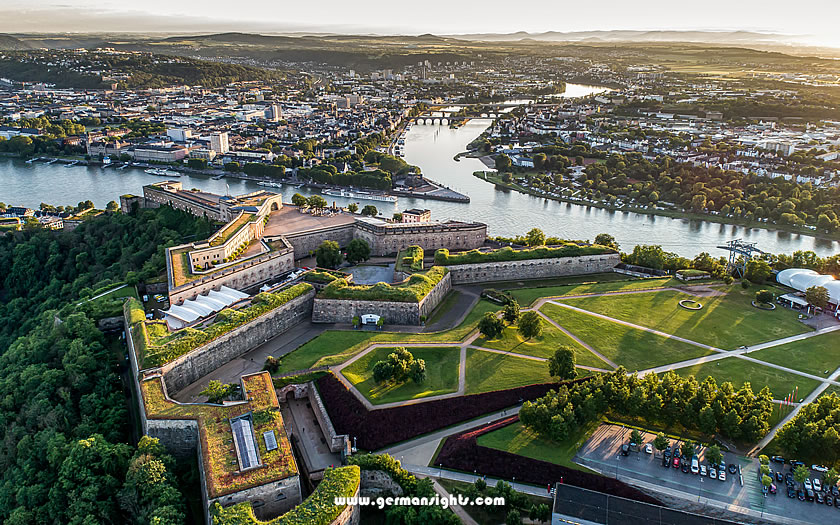
Ehrenbreitstein Fortress in Koblenz
Ehrenbreitstein Fortress is a large fortress situated on a hill overlooking the city of Koblenz and the confluence of the Rhine and Moselle rivers. It is one of the most impressive historic fortresses in Germany.
Construction began in 1817. It was designed as a massive, seemingly impregnable fortress to guard the important strategic junction of the two rivers and ensure Prussian control of this vital stretch of the Rhine.
The fortress complex consists of a series of fortifications, walls, towers, barracks, garrisons and magazines covering an area of over 40 hectares. It served primarily as a symbol of Prussian and later German military might.
The fortress was decommissioned in the 1920s after the defeat of Germany in World War I. It was originally meant to be razed to the ground by the terms of the Versailles Treaty but was saved after the intervention of high-ranking military officers from both sides.
Today Ehrenbreitstein is a listed building and a major tourist attraction in Koblenz. Visitors can explore the tunnels, courtyards and palace within the fortress complex.
The site also houses several museums, including the Koblenz State Museum ('Landesmuseum Koblenz') and the German Army Memorial, which pays tribute to the fallen soldiers of the First and Second World Wars.
During the summer months, it is the venue for several music festivals and for the spectacular 'Rhein in Flammen' firework display.
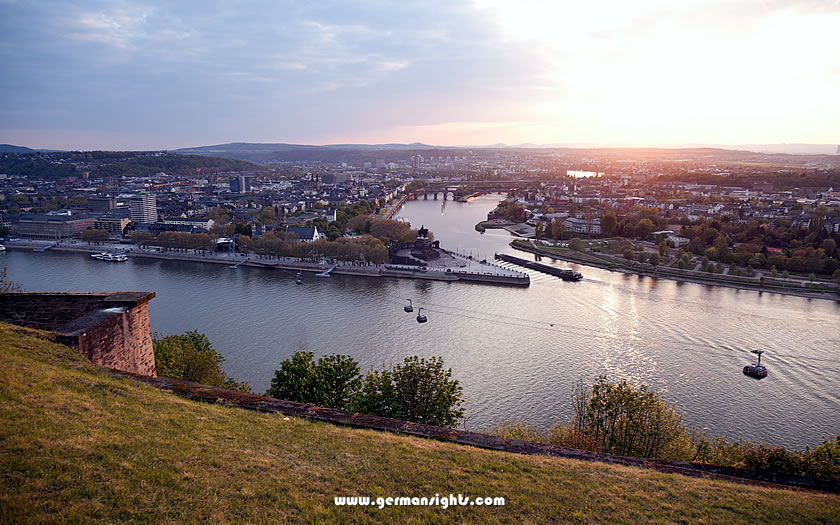
The cable car across the Rhine river in Koblenz
The fortress can be reached on foot, by a cable car which starts from the left bank of the Rhine, or by a funicular railway from the right bank of the Rhine.
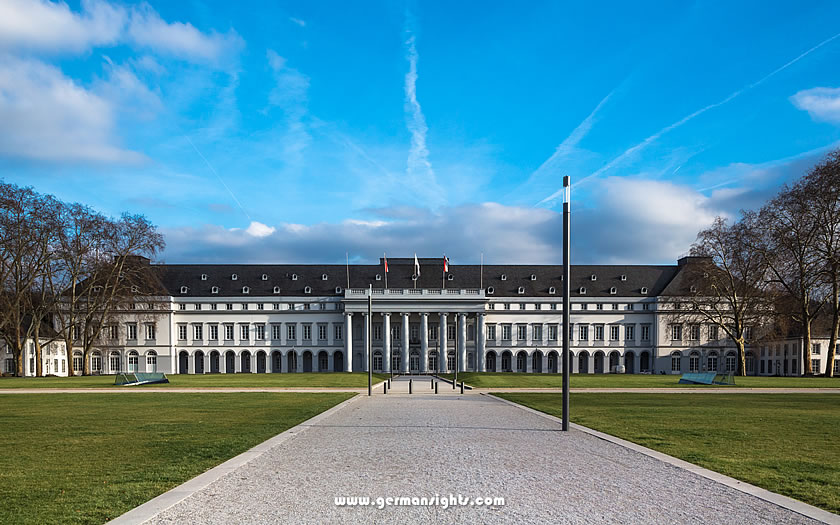
The Electoral Palace in Koblenz
The Electoral Palace ('Kurfürstliches Schloss') is situated on the banks of the Rhine river in Koblenz. It is the former residence of the Archbishops and Electors of Trier.
The palace was built at the end of the 18th century and is considered to be one of the last examples of the French classicism style of architecture constructed before the French Revolution took place.
Koblenz was occupied by the French revolutionary forces, which meant that the construction of the palace interior was never finished. It also meant an end to the independent Electorate of Trier.
When the area returned to Prussian control, the building was used as a residence by the governor of the Rhineland and later as administrative buildings in the 19th century and early 20th century. All but the exterior walls were destroyed during a bombing raid in World War II.
The palace was rebuilt in the 1950s but only a small central section of the interior rooms were restored to the original plans. The rest were converted into offices.
The palace gardens were also renovated and used for the German Horticultural Show in 2011. A smaller section of the gardens leads down behind the palace to the Rhine river bank and the river promenade.
The Schloßstraße now provides a direct link and view towards the palace and gardens from the Koblenz Stadtmitte train station.
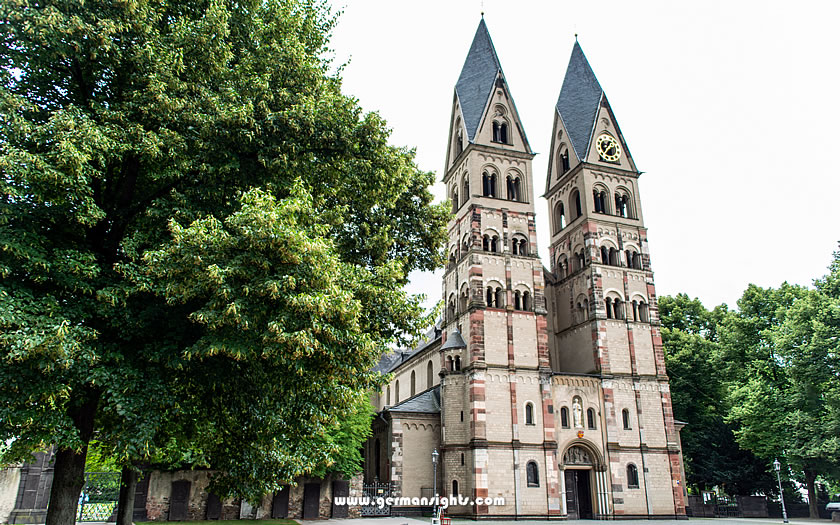
Basilica of St Castor in Koblenz
The Basilica of St Castor is the oldest surviving church in Koblenz. Consecrated in 836, the collegiate church was the meeting place and place of arbitration for emperors and kings and their descendants. The building in its present form dates mainly from the middle of the 12th century.
The Liebfrauenkirche was the main parish church of Koblenz from the late Middle Ages until the French Revolution. Its origins date back to the 5th century, when the Franks built a church on the site of an earlier Roman building. The distinctive onion domes were added in the 17th century, destroyed in 1944 and restored in 1955.
The Florinskirche is the Evangelical parish church and was originally built around 1100. It stands on the Florinsmarkt square, which was once the commercial heart of the old town and which houses an ensemble of protected historic buildings.
The Koblenz State Museum (mentioned above) covers quite a few themes in its home in the Ehrenbreitstein Fortress, including winemaking, photography and the cultural history of the region.
The Middle Rhine Museum ('Mittelrhein Museum') was founded in 1835 and is one of Germany’s oldest and most prestigious civic museums. The collection of art and sculptures is now housed in the Forum Confluentes (the same location as the city tourist office).
The Rhine Museum is devoted to exploring life on the river. It is located at the bottom of the hill where the Ehrenbreitstein Fortress is located on the right bank of the Rhine.
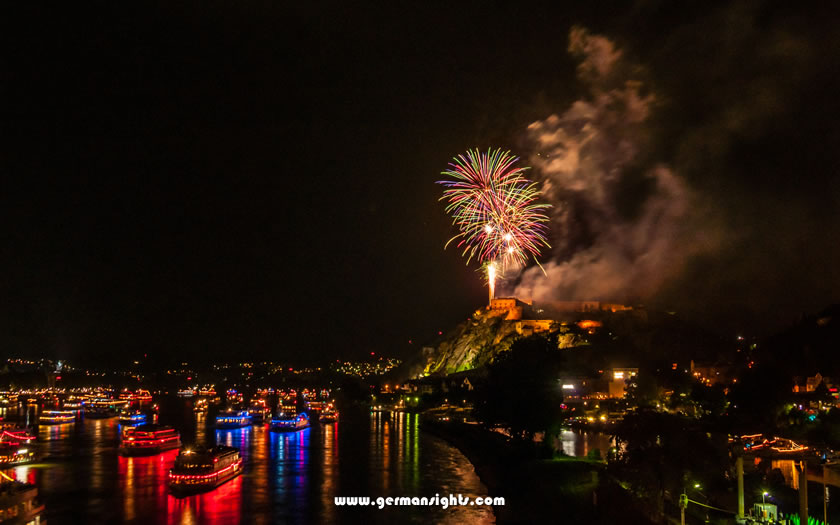
The 'Rhine in Flames' festival in Koblenz
The Koblenz Wine Festival is usually held over 80 days in spring and early summer, with different events celebrating the vineyards of the region and the winemaking history around the city.
The Altstadtfest ('Old Town Festival') takes place in the historic centre of Koblenz over three days in early July.
The Koblenzer Sommerfest ('Koblenz Summer Festival') is a three-day celebration which takes place around the massive Rhein in Flammen ('Rhine in Flames') fireworks display in August.
The Koblenz Christmas Market is held in six locations around the city, along with a Christmas village light installation created up on the Ehrenbreitstein Fortress grounds.
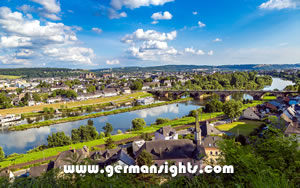
Trier is celebrated for its well-preserved Roman architecture, making it a historic gem in Germany. The city is home to the legendary Porta Nigra, an imposing monument that has stood since Roman times.
History enthusiasts can dive into the city’s rich past at the Rheinisches Landesmuseum, which houses a vast collection of Roman antiquities.
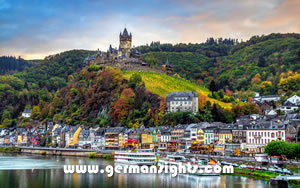
Cochem is renowned for its picturesque setting in the Moselle valley. The town’s most notable landmark, Cochem Imperial Castle, stands majestically on a hill and dates back to 1000 AD.
Visitors can ride a chairlift up to a spectacular view over the castle and surrounding countryside or wander through the charming old town with its half-timbered houses.
The Koblenz tourist office is located in the Forum Confluentes (a new triangular building just outside the old town). It is open seven days a week apart from major public holidays.
Tourist Office: www.visit-koblenz.de